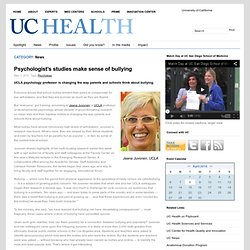

Creating cultures of dignity. Bullying Prevention: Tips for Teachers, Principals, and Parents. Updated 10/2013 Approximately 32 percent of students report being bullied at school.

Bullied students are more likely to take a weapon to school, get involved in physical fights, and suffer from anxiety and depression, health problems, and mental health problems. They suffer academically (especially high-achieving black and Latino students). And research suggests that schools where students report a more severe bullying climate score worse on standardized assessments than schools with a better climate.
This is all common sense to educators. Psychologist’s studies make sense of bullying UCLA psychology professor is changing the way parents and schools think about bullying.

Jaana Juvonen, UCLA Everyone knows that school bullies torment their peers to compensate for low self-esteem, and that they are scorned as much as they are feared. But “everyone” got it wrong, according to Jaana Juvonen, a UCLA professor of developmental psychology whose decade of groundbreaking research on mean kids and their hapless victims is changing the way parents and schools think about bullying. Most bullies have almost ridiculously high levels of self-esteem, Juvonen’s research has found.